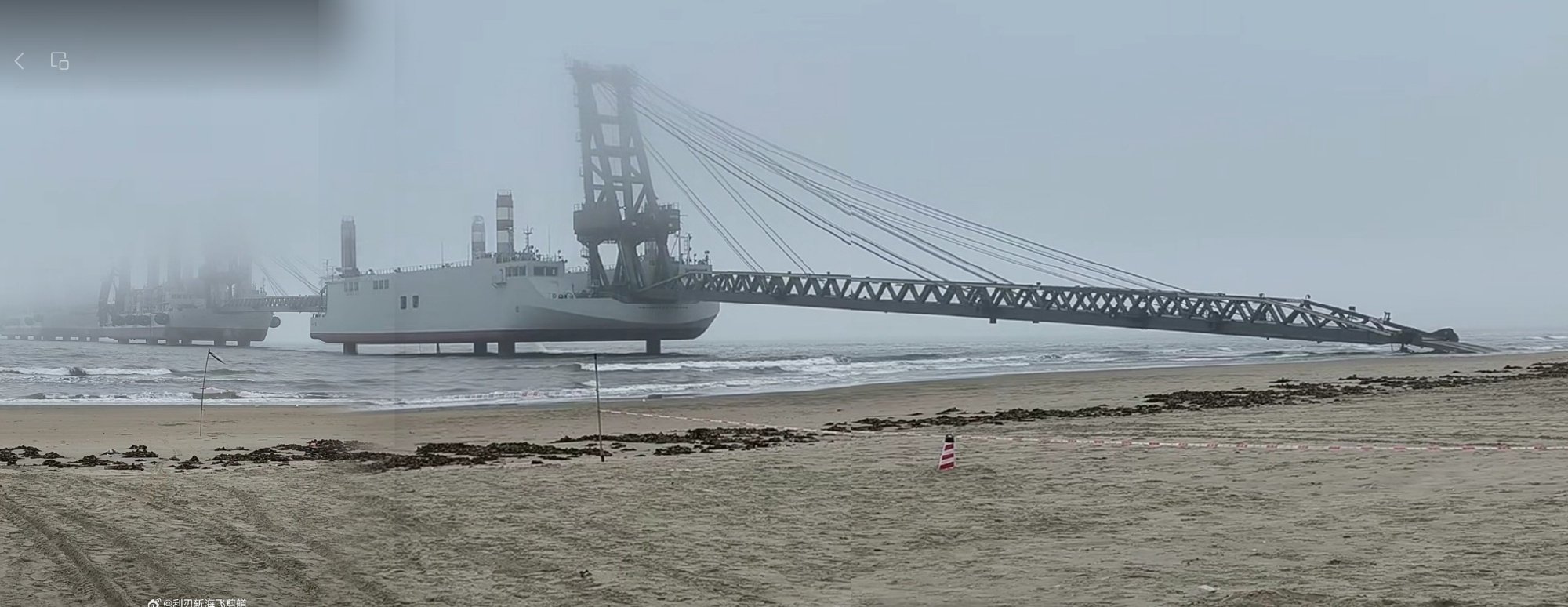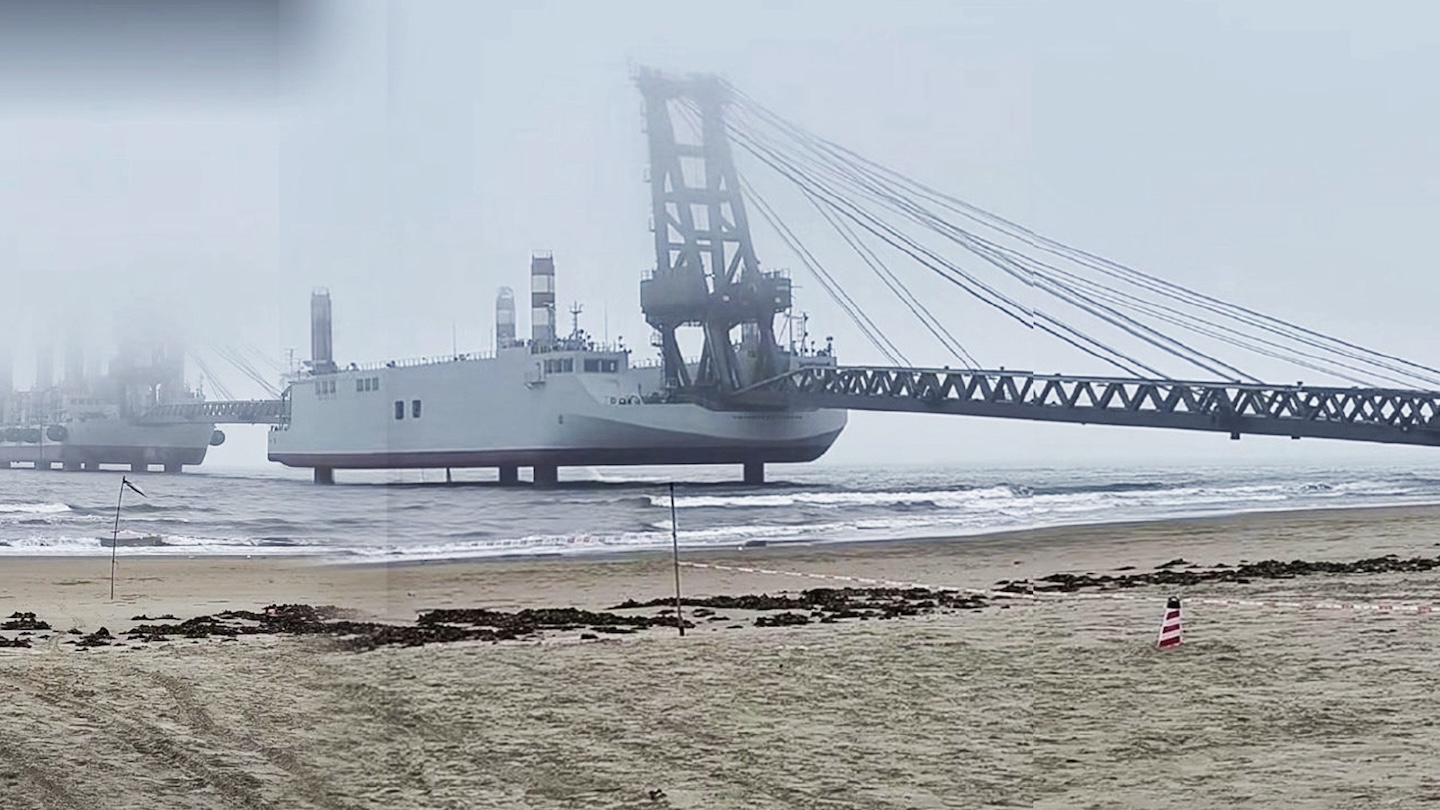New imagery has appeared of one of China’s new ‘invasion barges,’ which involves a temporary pier that can be connected to other vessels via a barge, or series of barges, with jack-up supports for more stability. The development of jack-up barges is widely seen as part of preparations for a possible invasion of Taiwan by the People’s Republic of China. At the same time, they also reflect the growing use of ostensibly non-military maritime assets to support amphibious operations by the Chinese People’s Liberation Army Navy (PLAN).
A new video showing three of the jack-up barges deployed in tandem on a still-unidentified beach began to circulate recently on social media channels.
Meanwhile, recent satellite imagery from Guangzhou Shipyard International (GSI) on Longxue Island, just southeast of the city of Guangzhou, confirms that three of the jack-up barges that were seen under construction there have departed. This development was identified by Tom Shugart, an adjunct senior fellow at the Center for a New American Security (CNAS) think tank.
Shugart refers to the barges as T-LPTs, for civilian-crewed auxiliary landing platform — transfer. According to his analysis, the three barges in question left Longxue Island sometime after March 9. Another three are still under construction at the GSI facility.
“After seeing the departure of these vessels, I went back and observed AIS data to see if the vessels were using AIS,” Shugart wrote on X, in reference to the automatic identification system that uses transceivers on ships to monitor their movements. “What I saw was indications of tugs getting these ships underway, but no AIS from the ships themselves, unlike other commercial vessels.”
Clearly, China either doesn’t want these vessels to be tracked or they are actually PLAN vessels. There is a precedent for the former, with dual-purpose ferries that take part in Chinese military exercises also not using AIS.
Most interesting, perhaps, is the way that the jack-up barges are deployed. Initially, analysts predicted that the three different-sized barges would likely be used independently, creating different-size mobile causeways leading to the beachhead. In the latest imagery, the three barges are coupled together to create one long causeway. Shugart calculates that this should be around 850 meters (930 yards) long.
Having much longer reach means that the causeway can be extended farther out to sea and into deeper water, where loads can be transferred onto them off of larger displacement vessels.
The latest development follows a previous image that appeared in January, showing a Chinese commercial roll-on/roll-off (RO/RO) ferry linked to a temporary pier via a different type of barge, with at least two — and possibly more — jack-up legs. TWZ provided an analysis of this earlier image at the time.
Before that, satellite imagery had emerged, showing multiple jack-up barges in various stages of construction at the GSI shipyard.
As we have noted in the past, there is a precedent for these kinds of temporary piers or causeways in a military context.
Only recently, the U.S. military made brief use of a temporary pier system to help increase the flow of humanitarian aid into the Gaza Strip. However, a squall broke apart that pier, putting it out of action for a while and demonstrating the potential vulnerability of such structures to severe weather.
Where the Chinese system differs, however, is in its use of struts, which literally jack the barge up, making it more stable and resilient to bad weather and able to remain in action in heavier sea states. This should also result in a much higher throughput of cargo, vehicles, and personnel. On the other hand, the construction also makes for a notably large target and very static high-value target, suggesting that it would be most relevant after an initial landing, supporting the arrival of mass follow-on forces and supplies after a degree of tactical stability has been established.
As can be seen in the new video, the barge closest to the beach has four prominent jack-up legs, the second barge has six, and the third and final one appears to have eight.

At the same time, jack-up barges are not new, with perhaps the best-known military example being the employment of so-called Mulberry harbors by Allied forces following the D-Day landings in Normandy, France, during World War II.
China, meanwhile, has at least a decade of experience using both semi-submersible and jack-up barges to connect ships, including ostensibly commercial RO/RO ferries, and temporary piers/causeways.

By now, there’s little doubt about the size and scope of the PLAN’s amphibious warfare aspirations and the fact that it expects to rely on commercial capabilities as well as distinctly military vessels.
Having access to this kind of additional capacity is widely seen in the context of supporting an invasion of Taiwan, although it has relevance in many other potential scenarios. The advantages of a hybrid military/civilian amphibious force could be leveraged for future military operations elsewhere in the Indo-Pacific, as well as for disaster relief and humanitarian assistance activities.
The importance of civilian vessels to China’s expanding amphibious capabilities is also underlined in the Pentagon’s most recent annual report on Chinese military developments, released in December last year. This states:
“Although the PLAN has not invested in the large number of landing ships and medium landing craft that analysts believe the PLA would need for a large-scale assault on Taiwan, it is possible the PLA assesses it has sufficient amphibious capacity and has mitigated shortfalls through investment in other operational capabilities, such as civilian lift vessels and rotary-wing assets to address this gap. The PLA may have confidence in the PRC’s shipbuilding industry’s massive capacity to produce the necessary ship-to-shore connectors relatively quickly.”
The value of temporary piers in this context has also not gone unnoticed.
“An over-the-shore capability like the floating causeway will be a critical capability in a Taiwan invasion, giving the PLA the capability to bypass damaged or sabotaged ports and harbors with an independent, relocatable off-shore loading and unloading capability,” a report from the independent China Maritime Studies Institute published last year explains. “At least through 2030, the PLA’s reserve civilian merchant fleet is probably unable to provide significant amphibious landing capabilities or the maritime logistics in austere or challenging environments necessary to support a large-scale, cross-strait invasion of Taiwan. That said, if current trends in training and exercises continue, the PLA may be able to effectively leverage civil maritime shipping on a large enough scale to support a major amphibious operation by the mid-2030s.”
An invasion or some other kind of military intervention against Taiwan on this kind of timeline is something that U.S. military officials have warned about for some time now. In the past, it had been suggested that Beijing might be able to launch such an operation by 2027, if not before, although U.S. officials have since stepped back somewhat from this more pessimistic analysis.
Nevertheless, the broad consensus in U.S. military circles is that Beijing remains committed to ‘unifying’ Taiwan with the mainland and that the Chinese military is working toward achieving the capabilities required to do this, however long that might take.
The continued development of jack-up barges suggests that these — as well as RO/RO ferries — will likely have an important role to play in any future Taiwan intervention. On the other hand, they are also relevant for a host of other potential applications as the PLAN continues to rely on commercial capabilities to boost its amphibious capacity.
Contact the author: thomas@thedrive.com
